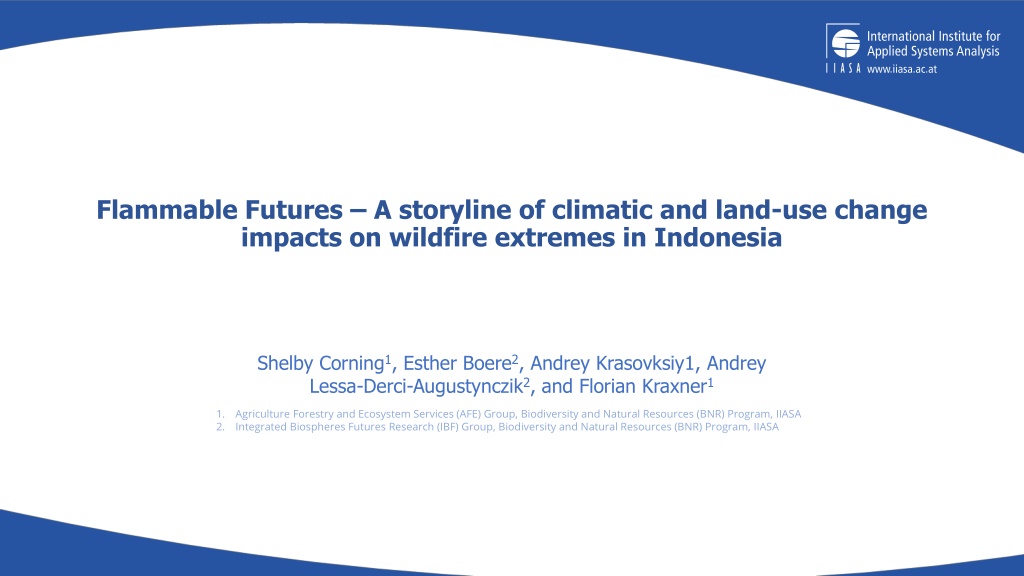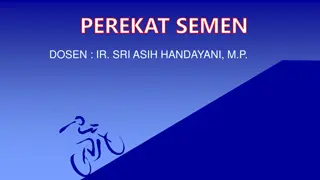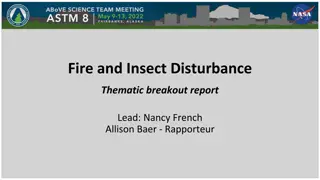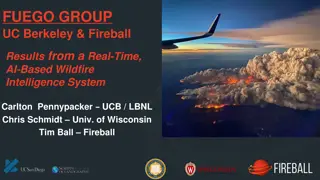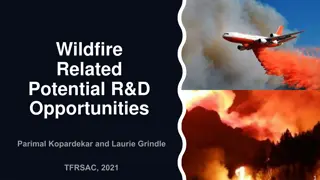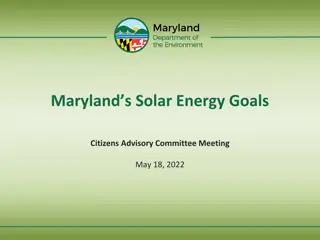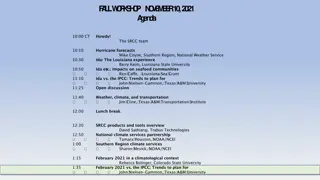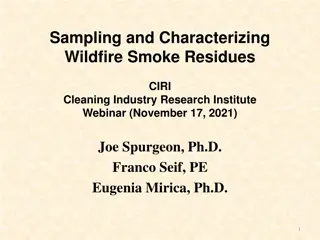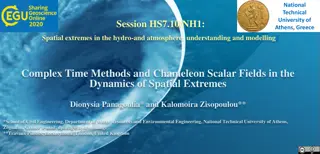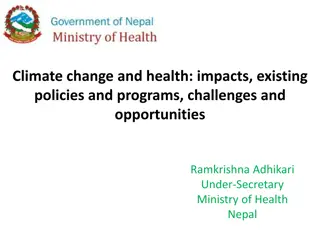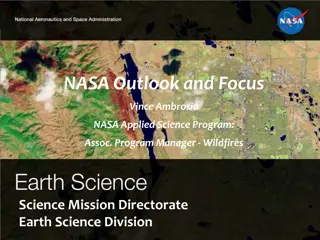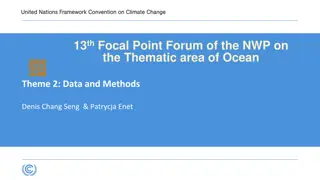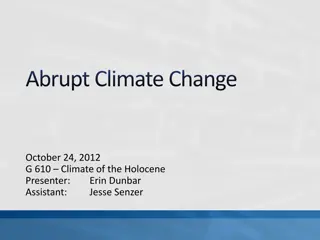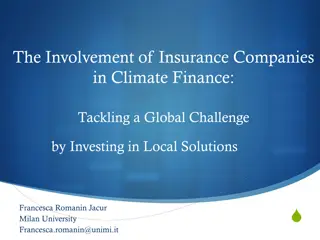Impacts of Climate Change on Wildfire Extremes in Indonesia
A study explores the impacts of climatic and land-use changes on wildfire extremes in Indonesia, focusing on current and future climate-driven fires. The research examines the influence of factors such as drought, economic policies, and adaptation efforts on burned areas, agricultural losses, and land use decisions. The analysis considers scenarios of climate warming and explores potential mitigation options to address the environmental and economic consequences of wildfires in Indonesia.
Uploaded on Sep 22, 2024 | 0 Views
Download Presentation

Please find below an Image/Link to download the presentation.
The content on the website is provided AS IS for your information and personal use only. It may not be sold, licensed, or shared on other websites without obtaining consent from the author. Download presentation by click this link. If you encounter any issues during the download, it is possible that the publisher has removed the file from their server.
E N D
Presentation Transcript
Flammable Futures A storyline of climatic and land-use change impacts on wildfire extremes in Indonesia Shelby Corning1, Esther Boere2, Andrey Krasovksiy1, Andrey Lessa-Derci-Augustynczik2, and Florian Kraxner1 1. 2. Agriculture Forestry and Ecosystem Services (AFE) Group, Biodiversity and Natural Resources (BNR) Program, IIASA Integrated Biospheres Futures Research (IBF) Group, Biodiversity and Natural Resources (BNR) Program, IIASA
Remote Climate Effects and their Impact on European sustainability, Policy and Trade (RECEIPT) Aim: to better understand how climate-driven drought events, economic policies, and adaptation efforts affect burned area, agricultural production losses, and land use decisions in Indonesia the impact of current and future climate-induced fires in Indonesia, their effects on market disturbances and the environment, and mitigation options 2 2
Overview Storyline theme Impact of current and future fires as influenced by climate, policy, and land use factors Hotspot area Indonesia Land use Agricultural oil palm plantations Climatic event Hazards Drought, wildfire Counterfactual climate change 2, 3, 4 degrees warming by 2050 Local impact of hazard, as related to wildfires Area burned or considered at high risk of wildfire; loss of biodiversity, forested land, oil palm production Potential impacts to Indonesia Environmental Burnt areas Loss of agricultural land, forested land Loss of biodiversity, forest resilience Economical Export volume Oil palm price and consumption Value added Alternative socio- economic scenarios 1. EU policy Reduction in demand from the EU by the share that s intended for biofuel use 2. Oil palm moratorium Ban on deforestation related to oil palm plantations in Indonesia Adaptation scenarios 1. No peatland conversion No land cover conversion of existing peatlands 2. Rewetting Restoration of peatlands from plantations or agricultural land 1
Methodology climatology and model chain Model chain of partial equilibrium biosphere management model (GLOBIOM) and wildfire impacts and climate adaptation model (FLAM) FLAM: Predict burned area (total and oil palm plantations) under these conditions GLOBIOM: Calculate market and environmental consequences due to predicted fire losses Consider El Nino event impacts on climatic parameters under +2, 3, 4 degrees warming (delta approach) Climate from 28 coupled models using historical and simulation data Separate climate change response from other drivers (eg Sea Surface Tension patterns) scale accordingly Estimate projected degrees of global warming in terms of changes to climate variables Add to isolated 2015 El Nino event Mean ensemble and high-risk climate change storylines Compare results between warming conditions and scenarios 3
Methodology FLAM Population, Peatland burning, Forest management Figure 2: Calibrated over 2000-09 and validated over 2010-16 using the Global Fire Emissions Database (GFED) dataset Figure 1: FLAM schematic. Run on a daily time-step at a resolution of 0.25 x 0.25 , aggregated to 0.5 x 0.5 polygons used by GLOBIOM Figure 3: Spatial distribution of modelled burned areas, 2015. ~1.6million ha, approximately 1.5% of Indonesia s total land mass 4
Results Overall increase in total burned area and production loss across scenarios and storylines High impact storyline resulted in higher burned areas and production losses than mean climate (ensemble) storyline Multiply burned area by productivity of oil palm plantations in grid cell to calculate loss due to fire Increase seen especially in southern islands of Indonesia (Sumatra and Kalimantan) agreement in observed and predicted trends of prominent drying response Production losses as great as 25% in southern islands under 4 degree warming Separated by land cover, oil palm area burned: 450,000 ha (actual) vs 515,000 ha (modelled) Figure 1: change in burned area across scenarios and storylines Production loss (1000 ha) Ensemble Production loss (1000 ha) High impact Degrees warming (C) Burned area (1000 ha) Ensemble 515.0 Burned area (1000 ha) High impact 515.0 1 (baseline) 7154.4 7154.4 2 567.0 (+9%) 568.0 (+9%) 7883.2 (+10) 7888.6 (+10%) 3 606.0 (+14%) 610.0 (+16%) 8440.4 (+18) 8478.3 (+19%) 4 645.0 (+20%) 650.0 (+24%) 8985.6 (+26%) 9044.9 (+26%) Table 1: change in burned area and palm oil production across scenarios and storylines 5
Results Area of oil palm burned: increases with each degree warming, both in absolute area and as a percentage of land cover burned 2.7% in 2015, 2.9% in +1, 3.4% in +3 Indonesia (top graph): Overall decrease in area allocated to palm oil plantations Overall decrease in calories consumed and total consumption Increase in price (+36-80.5%) Decrease in exports local supply impacted more! European Union (bottom graph) Overall decrease in imports, calories consumed, and total consumption Total change in trade flow: reduction of 70-103 thousand tons Increase in price (+1.5-2.6%) 5
Conclusions and next steps Across ensemble of climate scenarios and storylines (eg regardless of climate warming situation), burned area and oil palm production losses increased with each degree of warming Without intervention, we can expect an increase in frequency and extent of wildfires FLAM captured regional variability; GLOBIOM captured local and regional variability Next steps: To what extent can the climate impacts be mitigated through policy? Socio-economic adaptations Environmental adaptations To what extent does the environment/biodiversity suffer or recover under the above adaptations? 6
Thanks for your time and attention! Questions? For further information: FLAM http://www.iiasa.ac.at/flam Shelby Corning (corning@iiasa.ac.at) Andrey Krasovskiy (krasov@iiasa.ac.at) GLOBIOM http://www.iiasa.ac.at/globiom Esther Boere (boere@iiasa.ac.at) Andrey Lessa (augustynczik@iiasa.ac.at) 8
